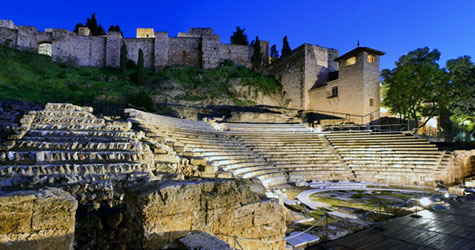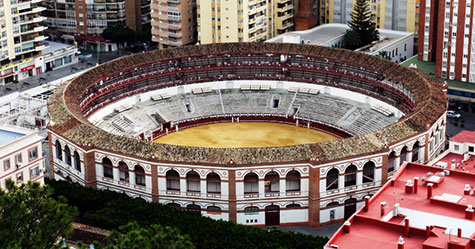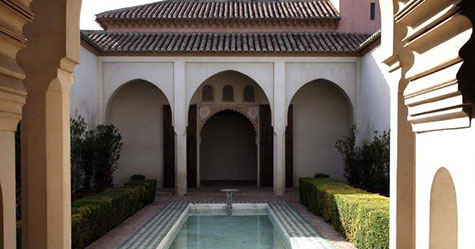 Malaga Roman Theater
Malaga Roman Theater Malaga Bullfighting Ring
Malaga Bullfighting Ring Malaga Alcazaba
Malaga AlcazabaLa Alcazaba ,representative of the medieval city, is a military fortress built by the Moors in the 11th century on the remains of a Romans fortress. The fortress lies on a hill top with good view over the town and the sea.
Its irregular and extensive design includes two walled precincts, a Palace(11th -14th Century), a residential area, patios with evocative names such as Los Naranjos (Orange trees), ancient arches, and a tower with marvellous views over the city.
In the street of Alcazabilla at the foot of the Alcazaba you will find the Roman Theater which dates back to the time of Augustus and which fell into disuse at the end of the 3rd century A.D. In its heyday, the walls of the auditorium were covered in marble.The Theatre is the finest example of Roman Architecture in Malaga.
It was not discovered until 1951 in spite of it's size with a radius of 31 meters and height of 19 meters. Studies have shown that the Moors used elements from the Theater in the construction of La Alcazaba.
Leaving the Alcazaba and crossing the Puerta Oscura gardens, you can reach the Gibralfaro castle. There are different theories as to its origins, and it could date back to the Phoenician-Carthaginian period, the place where the Gibralfaro lies is thought to have hosted a lighthouse built by the Phoenicians. On the remains of this lighthouse a fortress was build by Abderramn III and was later reconstructed as a castle by Yasuf I in the 14th century. The castle used to contain a mosque, but visitors nowadays can still see several wells, bread ovens and the old powder factory, which is now an information centre.From here, you can go up to the Parador de Gibralfaro, which has beautiful views over the ruins, the city and the sea.
The construction of the Cathedral in Malaga began in 1528 after conquering Malaga from the Moors. The construction was suspended in 1782 and it lacks a southern tower that is why the local people call it "La Manquita"(little one-armed lady). The cathedral (16th-18th century) was built on the site of the site of the Aljama mosque and contains treasures such as the Choir Stalls, classified as the eighth wonder of the world in the 18th century, works by Pedro de Mena, two spectacular organs with over 4000 pipes, and the cathedral museum.
This Church is situated between the Palace Episcopal and the Cathedral. It was build on the ruins of the major Arab mosque in the 15th century in a gothic style. Inside the church there is a fascinating altar build Juan de Balmaseda.
This is one of the oldest churches in Malaga and is located in calle Granada.It was built in 1490, shortly after the Reconquest, on the site of a former mosque.One of its main attractions is the Mudejar tower, decorated in traditional Amohade style.
The Sanctuary houses the statue of the city's patron saint, the Virgen de la Victoria, whose origin dates from the reconquest of the city by the catholic Kings in 1487. It was on this site that King Fernando camped before his victory against Moslem Malaga.The current sanctuary was built over the remains of the original one (1691).Don't miss the treasure-room tower and the crypt with the condesa de Buenavista's mausoleum.
 Malaga Roman Theater
Malaga Roman Theater Malaga Bullfighting Ring
Malaga Bullfighting Ring Malaga Alcazaba
Malaga AlcazabaThis palace was constructed in the 18th century as an exhibition hall for the Malagueos but was later acquired by a noble family in 1895 for personal premises. In 1986 it was bought back by the government and today hosts different associations.
This palace is situated next to the cathedral and is considered to represent the typical Malagueean architectural style from the 18th century. Today the Museum Diocesano is hosted in the palace.
This is the most important neoclassical building from the 18th century in Malaga, and is currently the headquarters of the Governmental Sub-delegate. In the room of the Pillars is an exhibition of pieces from the Fine Arts Museum.
The town hall was build between 1912 and 1919 and is one of the most remarkable modernistic buildings in Malaga.
The house of the consulate, which is situated on Plaza de la Constitucion, was build in the 18th century in a neo-classic style and is today declared a national historical monument.
The bullring was built between 1874-76. It is in classic style, and houses a museum dedicated to Antonio Ordoez, a legend in the world of bullfighting. It can be found in the Paseo de Reding. The bullfighting ring has a total capacity for about 15.000 people.
